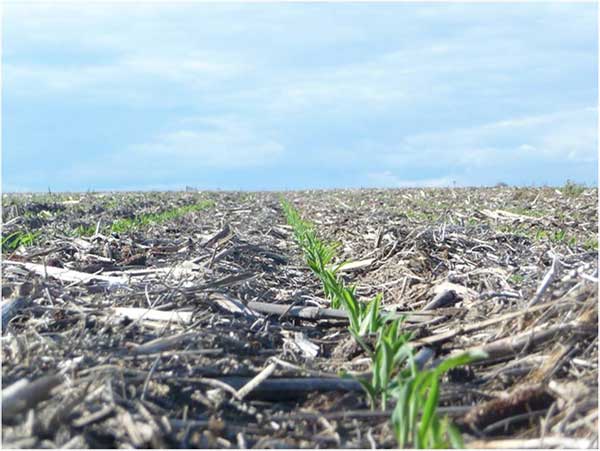|

|
Corn Has Not
Emerged, Should I be Concerned? No!
By Sam Custer
OSU Extension, Darke County
On Sunday I was talking to a producer who said that it is taking a long
time for corn to emerge.
I did some calculations for Darke County. Corn planted on April
18 has had 187 GDDs and is up and looking great while corn planted just
a week later corn on April 27 has had about 79 GDD’s and probably has
not emerged yet.
Is this cause for concern? According to Perter Thomison, Ohio State
University Corn Specialist, not necessarily.
In this week’s C.O.R.N. Newsletter he shared that corn requires about
100 growing degrees days (GDDs) to emerge (emergence requirements can
vary from 90 to 150 GDDs). To determine daily GDD accumulation,
calculate the average daily temperature (high + low)/2 and subtract the
base temperature which is 50 degrees F for corn. If the daily low
temperature is above 50 degrees, and the high is 86 or less, then this
calculation is performed using actual temperatures. If the low
temperature is less than 50 degrees, use 50 degrees as the low in the
formula. Similarly, if the high temperature is above 86 degrees, use 86
degrees in the formula. The high cutoff temperature (86 degrees F) is
used because growth rates of corn do not increase above 86 degrees F.
Growth at the low temperature cutoff (50 degrees F) is already near
zero, so it does not continue to slow as temperatures drop further.
If it takes a corn hybrid 100 GDDs to emerge, and daily high and low
temperatures average 70 and 50 degrees following planting, 10 GDDs
accumulate per day, and corn should emerge in about 10 days (100 GDDs
to emerge/10 GDDs per day = 10 days). However, if daily high and low
temperatures are cooler, averaging 60 and 45 degrees after planting, 5
GDDs accumulate per day, and it may take nearly 3 weeks (100 GDDs to
emerge/5 GDDs per day = 20 days) for corn to emerge.
Given this relationship between GDD accumulation and emergence, growers
should not be too surprised if their mid to late April planted corn
will require more time to emerge than later planted corn. While there
have been periods since mid- April when air temperatures have been
warmer than average, with maximum high temperatures above 70 degrees,
soil temperatures (as measured at the 2-inch soil depth) may be
considerably cooler, in the 50 to 60 degree F range. Seedling emergence
is dependent on soil temperature and air temperature. Also, keep in
mind that these estimates of emergence based on GDDs are approximate
and can be influenced by various factors including residue cover,
tillage, and soil organic matter (soil “color”) and moisture content.
For more information about OSU Extension, Darke County, visit the Darke
County OSU Extension web site at www.darke.osu.edu or the OSU Extension
Darke County Facebook page.
|

|
|
|
|

